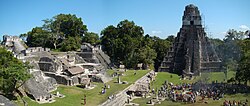
This is a list of pre-Columbian cultures.

This is a list of pre-Columbian cultures.


Many pre-Columbian civilizations established permanent or urban settlements, agriculture, and complex societal hierarchies. In North America, indigenous cultures in the Lower Mississippi Valley during the Middle Archaic period built complexes of multiple mounds, with several in Louisiana dated to 5600–5000 BP (3700 BC–3100 BC). Watson Brake is considered the oldest, multiple mound complex in the Americas, as it has been dated to 3500 BC. It and other Middle Archaic sites were built by pre-ceramic, hunter-gatherer societies. They preceded the better known Poverty Point culture and its elaborate complex by nearly 2,000 years. [1] The Mississippi Valley mound-building tradition extended into the Late Archaic period, longer than what later southeastern mound building dependent on sedentary, agricultural societies.(Russo, 1996:285) [1]
Some of these civilizations had long ceased to function by the time of the first permanent European arrivals (c. late 15th – early 16th centuries), and are known only through archaeological investigations or oral history from nations today. Others were contemporary with this period, and are also known from historical accounts of the time. A few, such as the Olmec, Maya, Mixtec, and Nahua had their own written records. However, most Europeans of the time viewed such texts as heretical and burned most of them. Only a few documents were hidden and thus remain today, leaving modern historians with glimpses of ancient culture and knowledge.
From both indigenous American and European accounts and documents, American civilizations at the time of European encounter possessed many impressive attributes, having populous cities, and having developed theories of astronomy and mathematics.
Where they persist, the societies and cultures which gave rise to these civilizations continue to adapt and evolve; they also uphold various traditions and practices which relate back to these earlier times, even if combined with those more recently adopted.
Human sacrifice was a religious practice principally characteristic of pre-Columbian Aztec civilization, although other Mesoamerican civilizations like the Maya and the Zapotec practiced it as well. The extent of the practice is debated by modern scholars.
In alphabetical order:

| Period | Dates | Cultures |
|---|---|---|
| Ceramic | ||
| Late Horizon | 1476 AD – 1534 AD | Ecuador, Peru, Bolivia, Argentina, Chile, and Colombia: Inca Empire; Brazil: Cambeba; Colombia: Muisca Confederation Argentina: Diaguita |
| Late Intermediate | 1000 AD – 1476 AD | Bolivia: Aymara kingdoms; Colombia: Muisca, Capuli, Tairona; Ecuador: Los Huancavilca, Kingdom of Quito, Manteño, Capuli; Peru: Chimú, Chincha, Cajamarca, Chiribaya, Piura, Chancay, Chachapoyas, Chiribaya, Chucuito, Huaman Huilca, Ilo, Lupaca, Qotu Qotu, Pacacocha, Palli Marca, Piura, Sican, Tajaraca, Huaylas, Conchucos, Huamachuco, Rucanas, Chanka, Ayabaca, Bracamoros, Huancabambas, Tallan culture, Huarco, Ichma, Parinacota, Cuntis, Chinchaycochas, Huarochiri, Kheswas, Tarmas, Paltas, Camanas; Argentina: Diaguita |
| Middle Horizon | 600 AD – 1000 AD | Bolivia: Tiwanaku (kin to Wari); Brazil: Marajoara culture; Colombia: Cauca culture, Herrera, Capuli, Quimbaya, Tairona; Ecuador: Cañari culture, Capuli; Peru: Chimu, Huari/Wari, Piura; Argentina: Diaguita |
| Early Intermediate | 200 AD–600 AD | Bolivia: Tiwanaku; Colombia: Herrera, Quimbaya, San Agustín, Tairona, Tierradentro, Tolima; Ecuador (the Upano Valley [8] ): La Bahía, Cara, Quitu; Peru: Moche, Nazca, Lima, Pechiche, Piura |
| Early Horizon | 900 BC–200 AD | Colombia: Calima culture (200 BC–400 AD), Herrera; Ecuador: Chorrera, La Tolita; Peru: Chavín, Cupisnique, Late Chiripa, Paracas, Pechiche, Sechura, Xakse |
| Initial Period | 1800/1500 BC – 900 BC | Ecuador: Cotocollao; Machalilla; Peru: Early Chiripa, Kotosh, Chavín Toríl (The Cumbe Mayo aqueduct was built c. 1000 BC), Argentina: Tehuelches (?-1820) |
| Preceramic | ||
| Period VI | 2500 BC – 1500/1800 BC | Ecuador: Valdivia; Peru: Casma/Sechin culture, Norte Chico (Caral), Buena Vista, Casavilca, Culebras, Ventarrón, Viscachani, Huaca Prieta; Peru, Chile: Chinchorro |
| Period V | 4200 BC – 2500 BC | Ecuador: Valdivia; Peru: Casma/Sechin culture, Norte Chico (Caral), Honda, Lauricocha III, Viscachani; Peru, Chile: Chinchorro |
| Period IV | 6000 BC – 4200 BC | Peru: Ambo, Canario, Siches, Lauricocha II, Luz, Toquepala II; Peru, Chile: Chinchorro |
| Period III | 8000 BC – 6000 BC | Ecuador: Las Vegas, 8000–4600 BC; Peru: Arenal, Chivateros II, Lauricocha I, Playa Chira, Puyenca, Toquepala I; Peru, Chile: Chinchorro |
| Period II | 9500 BC – 8000 BC | Ecuador: El Inga; Peru: Chivateros I, Lauricocha I |
| Period I | ? BC – 9500 BC | Colombia: El Abra, (12,500–10,000 BC); Peru: Oquendo, Red Zone (central coast); Argentina & Chile: Patagonia |